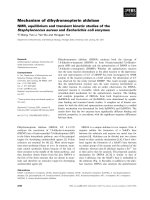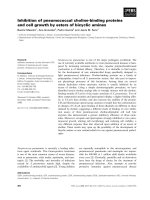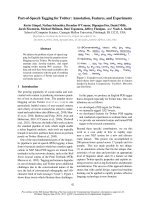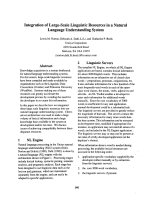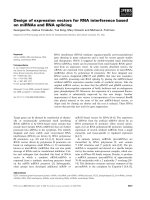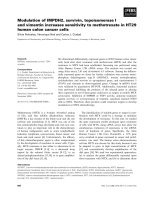Báo cáo khoa học: "Expansion of Multi-Word Terms for Indexing and Retrieval Using Morphology and Syntax" pdf
Bạn đang xem bản rút gọn của tài liệu. Xem và tải ngay bản đầy đủ của tài liệu tại đây (732.52 KB, 8 trang )
Expansion of Multi-Word Terms for Indexing and Retrieval
Using Morphology and Syntax*
Christian Jacquemin Judith L. Klavans
Institut de Recherche en Informatique Center for Research
de Nantes, BP 92208
2, chemin de la Houssini~re
44322 NANTES Cedex 3
FRANCE
j
acquemin@irin, univ-nantes, fr
Evelyne Tzoukermann
Bell Laboratories,
on Information Access Lucent Technologies,
Columbia University 700 Mountain Avenue, 2D-448,
535 W. ll4th Street, MC 1101 P.O. Box 636,
New York, NY 10027, USA Murray Hill, NJ 07974, USA
klavans@cs, columbia, edu evelyneQresearch,
bell-labs,
corn
Abstract
A system for the automatic production of
controlled index terms is presented using
linguistically-motivated techniques. This
includes a finite-state part of speech tagger,
a derivational morphological processor for
analysis and generation, and a unification-
based shallow-level parser using transfor-
mational rules over syntactic patterns. The
contribution of this research is the success-
ful combination of parsing over a seed term
list coupled with derivational morphology
to achieve greater coverage of multi-word
terms for indexing and retrieval. Final re-
sults are evaluated for precision and recall,
and implications for indexing and retrieval
are discussed.
1 Motivation
Terms are known to be excellent descriptors of the
informational content of textual documents (Sriniva-
san, 1996), but they are subject to numerous linguis-
tic variations. Terms cannot be retrieved properly
with coarse text simplification techniques (e.g. stem-
ming); their identification requires precise and effi-
cient NLP techniques. We have developed a domain
independent system for automatic term recognition
from unrestricted text. The system presented in this
paper takes as input a list of controlled terms and
a corpus; it detects and marks occurrences of term
We would like to thank the NLP Group of Columbia
University, Bell Laboratories - Lucent Technologies, and
the Institut Universitaire de Technologie de Nantes for
their support of the exchange visitor program for the
first author. We also thank the Institut de l'Information
Scientifique et Technique (INIST-CNRS) for providing
us with the agricultural corpus and the associated term
list, and Didier Bourigault for providing us with terms
extracted from the newspaper corpus through LEXTER
(Bourigault, 1993).
variants within the corpus. The system takes as in-
put a precompiled (automatically or manually) term
list, and transforms it dynamically into a more com-
plete term list by adding automatically generated
variants. This method extends the limits of term
extraction as currently practiced in the IR commu-
nity: it takes into account multiple morphological
and syntactic ways linguistic concepts are expressed
within language. Our approach is a unique hybrid
in allowing the use of manually produced precom-
piled data as input, combined with fully automatic
computational methods for generating term expan-
sions. Our results indicate that we can expand term
variations at least 30% within a scientific corpus.
2 Background and Introduction
NLP techniques have been applied to extraction
of information from corpora for tasks such as free
indexing
(extraction of descriptors from corpora),
(Metzler and Haas, 1989; Schwarz, 1990; Sheridan
and Smeaton, 1992; Strzalkowski, 1996),
term ac-
quisition
(Smadja and McKeown, 1991; Bourigault,
1993; Justeson and Katz, 1995; Dallle, 1996), or
ex-
traction of lin9uistic information
e.g. support verbs
(Grefenstette and Teufel, 1995), and event structure
of verbs (Klavans and Chodorow, 1992).
Although useful, these approaches suffer from two
weaknesses which we address. First is the issue of
filtering term lists; this has been dealt with by cons-
traints on processing and by post-processing over-
generated lists. Second is the problem of difficulties
in identifying related terms across parts of speech.
We address these limitations through the use of
con-
trolled indexing,
that is, indexing with reference to
previously available authoritative terms lists, such as
(NLM, 1995). Our approach is fully automatic, but
permits effective combination of available resources
(such as thesauri) with language processing techno-
logy, i.e., morphology, part-of-speech tagging, and
syntactic analysis.
24
Automatic controlled indexing is a more difficult
task than it may seem at first glance:
• controlled indexing on single-words must
account for polysemy and word disambiguation
(Krovetz and Croft, 1992; Klavans, 1995).
• controlled indexing on multi-word terms must
consider the numerous forms of term va-
riations (Dunham, Pacak, and Pratt, 1978;
Sparck Jones and Tait, 1984; Jacquemin, 1996).
We focus here on the multi-word task. Our
system exploits a morphological processor and a
transformation-based parser for the extraction of
multi-word controlled indexes.
The action of the system is twofold. First, a cor-
pus is enriched by tagging each word unambiguously,
and then expanded by linking each word with all its
possible derivatives. For example, for English, the
word genes is tagged as a plural noun and morpho-
logically connected to genic, genetic, genome, ge-
notoxic, genetically, etc. Second, the term list is
dynamically expanded through syntactic transfor-
mations which allow the retrieval of term variants.
For example, genic expressions, genes were expres-
sed, expression of this gene, etc. are extracted as
variants of gene expression.
This system relies on a full-fledged unification for-
malism and thus is well adapted to a fine-grained
identification of terms related in syntactically and
morphologically complex ways. The same system
has been effectively applied both to English and
French, although this paper focuses on French (see
(Jacquemin, 1994) for the case of syntactic variants
in English). All evaluation experiments were perfor-
med on two corpora: a training corpus [ECI] (ECI,
1989 and 1990) used for the tuning of the metagram-
mar and a test corpus [AGR] (AGR, 1995) used for
evaluation. [ECI] is a subset of the European Corpus
Initiative data composed of 1.3 million words of the
French newspaper "Le Monde"; [AGR] is a set of
abstracts of scientific papers in the agricultural do-
main from INIST/CNRS (1.1 million words). A list
of terms is associated with each corpus: the terms
corresponding to [ECI] were automatically extrac-
ted by LEXTER (Bourigault, 1993) and the terms
corresponding to [AGR] were extracted from the
AGROVOC term list owned by INIST/CNRS.
The following section describes methods for grou-
ping multi-word term variants; Section 4 presents
a linguistically-motivated method for lexical analy-
sis (inflectional analysis, part of speech tagging, and
derivational analysis); Section 5 explains term ex-
pansion methods: constructions with a local parse
through syntactic transformations preserving depen-
dency relations; Section 6 illustrates the empirical
tuning of linguistic rules; Section 7 presents an eva-
luation of the results in terms of precision and recall.
3 Variation in Multi-Word Terms: A
Description of the Problem
Linguistic variation is a major concern in the studies
on automatic indexing. Variations can be classified
into three major categories:
• Syntactic (Type 1): the content words of
the original term are found in the variant but
the syntactic structure of the term is modified,
e.g. technique for performing volumetric mea-
surements is a Type 1 variant of measurement
technique.
•
Morpho-syntaetic (Type 2): the content
words of the original term or one of their deri-
vatives are found in the variant. The syntactic
structure of the term is also modified, e.g. ele-
ctrophoresed on a neutral polyaerylamide gel is
a Type 2 variant of gel electrophoresis.
• Semantic (Type 3): synonyms are found in
the variant; the structure may be modified, e.g.
kidney function is a Type 3 variant of renal fun-
ction.
This paper deals with Type 1 and Type 2 variations.
The two main approaches to multi-word term con-
flation in IR are text simplification and structural
similarity. Text simplification refers to traditional
IR algorithms such as (1) deletion of stop words,
(2) normalization of single words through stemming,
and (3) phrase construction through dictionary mat-
ching. (See (Lewis, Croft, and Bhandaru, 1989;
Smeaton, 1992) on the exploitation of NLP tech-
niques in IR.) These methods are generally limited.
The morphological complexity of the language seems
to be a decisive argument for performing rich stem-
ming (Popovi~ and Willett, 1992). Since we focus
on French, a language with a rich declensional infle-
ctional and derivational morphology we have cho-
sen the richest and most precise morphological ana-
lysis. This is a key component in the recognition
of Type 2 variants. For structural similarity, co-
arse dependency-based NLP methods do not account
for fine structural relations involved in Type 1 va-
riants. For instance, properties of flour should be
linked to flour properties, properties of wheat flour
but not to properties of flour starch (examples are
from (Schwarz, 1990)). The last occurrence must be
rejected because starch is the argument of the head
25
noun
properties,
whereas
flour
is the argument of
the head noun
properties
in the original term. Wi-
thout careful structural disambiguation over internal
phrase structure, these important syntactic distinc-
tions would be incorrectly overlooked.
4 Part of Speech Disambiguation
and Morphology
First, inflectional morphology is performed in or-
der to get the different analyses of word forms. Infle-
ctional morphology is implemented with finite-state
transducers on the model used for Spanish (Tzouker-
mann and Liberman, 1990). The theoretical prin-
ciples underlying this approach are based on gene-
rative morphology (Aronoff, 1976; Selkirk, 1982).
The system consists of precomputing stems, extrac-
ted from a large dictionary of French (Boyer, 1993)
enhanced with newspaper corpora, a total of over
85,000 entries.
Second, a finite-state part of speech tagger
(Tzoukermann, Radev, and Gale, 1995; Tzouker-
mann and Radev, 1996) performs the morpho-
syntactic disambiguation of words. The tagger takes
the output of inflectional morphological analysis and
through a combination of linguistic and statistical
techniques, outputs a unique part of speech for each
word in context. Reducing the ambiguity of part of
speech tags eliminates ambiguity in local parsing.
Furthermore, part of speech ambiguity resolution
permits construction of correct derivational links.
Third, derivational morphology (Tzoukermann
and Jacquemin, 1997) is achieved to generate mor-
phological variants of the disambiguated words. De-
rivational generation is performed on the lemmas
produced by the inflectional analysis and the part of
speech information. Productive stripping and con-
catenation rules are applied on lemmas.
The derived forms are expressed as tokens with
feature structures 1. For instance, the following set
of constraints express that the noun
modernisateur
is
morphologically related to the word
modernisation 2 .
The <ON> metarule removes the
-ion
suffix, and
the <EUR> rule adds the nominal suffix
-eur.
1In the remainder of the paper, N is Noun, A
Adjective, C Coordinating conjunction, D Determiner,
P Preposition, Av Adverb, Pu Punctuation, NP Noun
Phrase, and AP Adjective Phrase.
2Each lemma has a unique numeric identifier
<reference>.
<cat> =- N
<lemma> =- 'modernisation'
<reference> = 52663
<derivation cat> N
<derivation lemma> = 'modernisateur'
<derivation reference> = 52662
<derivation history> '<ON<>EUR>'.
The morphological analysis performed in this
study is detailed in (Tzoukermann, Klavans, and
Jacquemin, 1997). It is more complete and linguis-
tically more accurate than simple stemming for the
following reasons:
• Allomorphy is accounted for by listing the set
of its possible allomorphs for each word. A1-
lomorphies are obtained through multiple verb
stems, e.g.
]abriqu-, ]abric-
(fabricate) or addi-
tional allomorphic rules.
• Concatenation of several suffixes is accounted
for by rule ordering mechanisms. Furthermore,
we have devised a method for guessing possible
suffix combinations from a lexicon and a corpus.
This empirical method reported in (Jacquemin,
1997) ensures that suffixes which are related wi-
thin specific domains are considered.
• Derivational morphology is built with the pers-
pective of overgeneration. The nature of the se-
mantic links between a word and its derivational
forms is not checked and all allomorphic alter-
nants are generated. Selection of the correct
links occurs during subsequent term expansion
process with collocational filtering. Although
dtable
(cowshed) is incorrectly related to
dtablir
(to establish), it is very improbable to find a
context where
dtablir
co-occurs with one of the
three words found in the three multi-word terms
containing
dtable: nettoyeur
(cleaner),
alimen-
ration
(feeding), and
liti~re
(litter): Since we
focus on multi-word term variants, overgenera-
tion does not present a problem in our system.
5 Transformation-Based Term
Expansion
The extraction of terms and their variants from cor-
pora is performed by a unification-based parser. The
controlled terms are transformed into grammar rules
whose syntax is similar to
PATR-II.
5.1 A Corpus-Based Method for
Discovering Syntactic Transformations
We present a method for inferring transformations
from a corpus in the purpose of developing a gram-
26
mar of syntactic transformations for term variants.
To discover the families of term variants, we first
consider a notion of collocation which is less restri-
ctive than variation. Then, we refine this notion in
order to filter out genuine variants and to reject spu-
rious ones. A Type 1 collocation of a binary term
is a text window containing its content words wl
and w2, without consideration of the syntactic stru-
cture. With such a definition, any Type 1 variant is
a Type 1 collocation. Similarly, a notion of Type 2
collocation is defined based on the co-occurence of
wl and w2 including their derivational relatives.
A d=5-word window is considered as sufficient for
detecting collocations in English (Martin, A1, and
Van Sterkenburg, 1983). We chose a window-size
twice as large because French is a Romance language
with longer syntactic structures due to the absence
of compounding, and because we want to be sure
to observe structures spanning over large textual se-
quences. For example, the term perte au stockage
(storage loss) is encountered in the [AGR] corpus as:
pertes occasionndes par les insectes au sorgho stockd
(literally: loss of stored sorghum due to the insects).
A linguistic classification of the collocations which
are correct variants brings up the following families
of variations a.
• Type 1 variations are classified according to
their syntactic stucture.
1. Coordination: a coordination the combi-
nation of two terms with a common head
word or a common argument. Thus, fruits
et agrumes tropicaux (literally: tropical ci-
trus fruits or fruits) is a coordination va-
riant of the term fruits tropicaux (tropical
fruits).
2. Substitution/Modification: a substitu-
tion is the replacement of a content word
by a term; a modification is the insertion
of a modifier without reference to another
term. For example, activitd thermodyna-
mique de l'eau (thermodynamic activity of
water) is a substitution variant of activitg
de l'eau (activity of water) if activitd ther-
modynamique (thermodynamic activity) is
a term; otherwise, it is a modification.
3. Compounding/Decompounding: in
French, most terms have a compound noun
structure, i.e. a noun phrase structure
where determiners are omitted such as con-
sommation d'oxyg~ne (oxygen consump-
tion). The decompounding variation is the
3 Variations are generic linguistic functions and va-
riants are transformations of terms by these functions.
transformation of a term with a compound
structure into a noun phrase structure such
as consommation de l'oxyg~ne (consump-
tion of the oxygen). Compounding is the
reciprocal transformation.
• Type 2 variations are classified according to
the nature of the morphological derivation. Of-
ten semantic shifts are involved as well (Viegas,
Gonzalez, and Longwell, 1996).
1. Noun-Noun variations: relations such
as result/agent (fixation de l'azote (ni-
trogen fixation) / fixateurs d ' azote (nitrogen
fixater)) or container/content (rdservoir
d ' eau (water reservoir) / rdserve en eau (wa-
ter reserve)) are found in this family.
2. Noun-Verb variations: these variations
often involve semantic shifts such as pro-
cess/result fixation de l'azote/fixer l'azote
(to fix nitrogen).
3. Noun-Adjective variations: the two
ways to modify a noun, a prepositional
phrase or an adjectival phrase, are gene-
rally semantically equivalent, e.g. variation
du climat (climate variation) is a synonym
of variation climatique (climatic variation).
A method for term variant extraction based on
morphology and simple co-occurrences would be
very imprecise. A manual observation of collocations
shows that only 55% of the Type 1 collocations are
correct Type 1 variants and that only 52% of the
Type 2 collocations are correct Type 2 variants. It
is therefore necessary to conceive a filtering method
for rejecting fortuitous co-occurrences. The follo-
wing section proposes a filtering system based on
syntactic patterns.
6 Empirical Rule Tuning
6.1 Syntactic Transformations for Type 1
and
Type 2 variants
The concept of a grammar of syntactic transforma-
tions is motivated by well-known observations on the
behavior of collocations in context (e.g. (Harris et
al., 1989).) Initial rules based on surface syntax are
refined through incremental experimental tuning.
We have devised a grammar of French to serve as a
basis for the creation of metarules for term variants.
For example, the noun phrase expansion rule is4:
NP -~ D: AP*N (APIPP)* (1)
awe use UNIX regular expression symbols for rules
and transformations.
27
From this rule a set of expansions can be generated:
NP = D ? (Av ? A)* N (Av ? A I (2)
P D ? (Av ? A)* N (Av ? A)*)*
In order to balance completeness and accuracy, ex-
pansions are limited. After the initial expansion is
created for a range of structures, empirical tuning is
applied to create a set of maximum coverage meta-
rules.
We briefly illustrate this process for coordina-
tion. For this example, we restrict transformations
to terms with N P N structures which represent a full
33% of the binary terms. Examples of metarules of
Type 1 and Type 2 variations are given in Table 1.
6.2 Development of a
Coordination
Transformation for N P N Terms
The coordination types are first calculated by combi-
ning the pattern N1 P2 Ns with possible expansions
of a noun phrase with a simple paradigmatic struc-
ture A TN(AIPD ? A ?NAT)s:
Coord(N1 P2 Ns) = N1 ((C A T N A T P) I (3)
(A C P) I (P D? AT N A T C P?)) N3
The first parenthesis (C A T N A ? P) represents a
coordinated head noun, the second (A C P) and
third (P D ? A T N A T C P?) represent respectively
an adjective phrase and a prepositional phrase coor-
dinated with the prepositional phrase of the original
term.
Variants were extracted on the [ECI] corpus
through this transformation; the following observa-
tions and changes have been made.
First, coordination accepts a substitution which
replaces the noun N3 with a noun phrase D ? A T Ns.
For example, the variant tempdrature et humiditd
initiale de Pair (temperature and initial humidity of
the air) is a coordination where a determiner pre-
cedes the last noun (air).
Secondly, the observations of coordination va-
riants also suggest that the coordinating conjunction
can be preceded by an optional comma and followed
by an optional adverb, e.g. la production, et sur-
tout la diffusion des semences (the production, and
particularly the distribution of the seeds).
Thirdly, variants such as de l'humiditd et de la
vitesse de l'air (literally: of humidity and of the
speed of the air) indicate that the conjunction can be
followed by an optional preposition and an optional
determiner.
5Subscripts represent indexing.
The three preceding changes are made on the ex-
pression of (3) and the resulting transformation is
given in the first line of Table 1 (changes are under-
lined).
Our empirical selection of valid metarules is gui-
ded by linguistic considerations and corpus observa-
tions. This mode of grammar conception has led us
to the following decisions:
• reject linguistic phenomena which could not be
accounted for by regular expressions such as
sentential complements of nouns;
• reject noisy and inaccurate variations such as
long distance dependencies (specifically within
a verb phrase);
• focus on productive and safe variations which
are felicitously represented in our framework.
Accounting for variants which are not considered in
our framework would require the conception of a no-
vel framework, probably in cooperation with a dee-
per analyzer. It is unlikely that our transformatio-
nal approach with regular expressions could do much
better than the results presented here. Table 2 shows
some variants of AGROVOC terms extracted from
the [AGR] corpus.
7 Evaluation
The precision and recall of the extraction of term va-
riants are given in Table 4 where precision is the ra-
tio of correct variants among the variants extracted
and the recall is the ratio of variants retrieved among
the collocates. Results were obtained through a ma-
nual inspection of 1,579 Type 1 variants, 823 Type 2
variants, 3,509 Type 1 collocates, and 2,104 Type 2
collocates extracted from the [AGR] corpus and the
AGROVOC term list.
These results indicate a very high level of accu-
racy: 89.4% of the variants extracted by the system
are correct ones. Errors generally correspond to a se-
mantic discrepancy between a word and its morpho-
logically derived form. For example, dlevde pour un
sol (literally: high for a soil) is not a correct variant
of dlevage hors sol (off-soil breeding) because dlevde
and dlevage are morphologically related to two dif-
ferent senses of the verb dlever:, dlevde derives from
the meaning to raise whereas dlevage derives from
to
breed. Recall is weaker than precision because only
75.2% of the possible variants are retrieved.
Improvement of Indexing through
Variant
Extraction
For a better understanding of the importance of
term expansion, we now compare term indexing with
28
Table 1: Metarules of Type 1 (Coordination) and Type 2 (Noun to Verb) Variations.
Variation Term and variant
Coord(N1
P2 N3) = NI (((Pu: C Av T
pT D ? A T NAT P) {(ACAv T P)
I(pDT ATNA T CAv T pT))D T A T) Ns.
teneur en protgine
(protein content)
-~ teneur en eau et en protdine
(protein and
water content)
NtoV(Nx
P2
N3) Vl (Av T
(pT D I P) AT)
N3: stabilisation de prix
(price stabilization)
<Vx derivation reference> = <N1 reference>.
~ stabiliser leurs prix
(stabilize their prices)
Table 2: Examples of Variations from [AGR].
Term Variant Type
Eehange d'ion
(ion exchange)
Culture de eellules
(cell culture)
Propridtd chimique
(chemical property)
Gestion d ' eau
(water management)
Eau de surface
(surface water)
Huile de palme
(palm oil)
Initiation de bourgeon
(bud initiation)
dchange ionique
(ionic exchange) N to A
cultures primaires de cellules
(primary cell cultures) Modif.
propridtds physiques et chimiques
Coor.
(chemical and physical properties)
gestion de l'eau
(management of the water) Comp.
eau et de l'dvaporation de surface
Coor.
(water and of surface evaporation [incorrect variant])
palmier d huile
(palm tree [yielding oil]) N to N
initier des bourgeons
N to V
(initiate buds)
and without variant expansion. The [AGR] corpus
has been indexed with the
AGROVOC
thesaurus in
two different ways:
1. Simple indexing: Extraction of occurrences of
multi-word terms without considering variation.
2. Rich indexing: Simple indexing improved with
the extraction of variants of multi-word terms.
Both indexings have been manually checked. Simple
indexing is almost error-free but does not cover term
variants. On the contrary, rich indexing is slightly
less accurate but recall is much higher. Both me-
thods are compared by calculating the effectiveness
measure (Van Rijsbergen, 1975):
1
E~=l-a(_~)+(l_a)(_~) with0<a<l (4)
P and R are precision and recall and a is a para-
meter which is close to 1 if precision is preferred to
recall. The value of E~ varies from 0 to 1; E~ is
close to 0 when all the relevant conflations are made
and when no incorrect one is made.
The effectiveness of rich indexing is more than
three times better than effectiveness of simple in-
dexing. Retrieved variants increase the number
Table 3: Evaluation of Simple vs. Rich Indexing.
Precision Recall Eo.s
Simple indexing 99.7% 72.4% 16.1%
Rich indexing 97.2% 93.4% 4.7%
of indexing items by 28.8% (17.3% Type 1 va-
riants and 11.5% Type 2 variants). Thus, term va-
riant extraction is a significant expansion factor for
identifying morphologically and syntactically related
multi-word terms in a document without introducing
undesirable noise.
As for performance, the parser is fast enough for
processing large amounts of textual data due to the
presence of several optimization devices. On a Pen-
tium133 with Linux, the parser processes 18,100
words/min from an initial list of 4,300 terms.
Conclusion
This paper has proposed a syntax-based approach
via morphologically derived forms for the identifi-
cation and extraction of multi-word term variants.
29
Table 4: Precision and Recall of Term Variant Extraction on [AGR]
Type 1 variants Type 2 variants
Total
Subst. Coord. Comp. AtoN NtoA NtoN NtoV
# correct 808 228 404 19 60 273 471 2263
# rejected 87 26 26 7 5 28 90 269
90.3% 90.0% 94.0% 73.1% 91.6% 93.0% 84.0%
Precision 89.4~o
91.2% 86.4%
Recall 75.0% 75.6%
75.2%
In using a list of controlled terms coupled with a
syntactic analyzer, the method is more precise than
traditional text simplification methods. Iterative ex-
perimental tuning has resulted in wide-coverage lin-
guistic description incorporating the most frequent
linguistic phenomena.
Evaluations indicate that, by accounting for term
variation using corpus tagging, morphological deri-
vation, and transformation-based rules, 28.8% more
can be identified than with a traditional indexer
which cannot account for variation. Applications to
be explored in future research involve the incorpo-
ration Of the system as part of the indexing module
of an IR system, to be able to accurately measure
improvements in system coverage as well as areas of
possible degradation. We also plan to explore analy-
sis of semantic variants through a predicative repre-
sentation of term semantics. Our results so far indi-
cate that using computational linguistic techniques
for carefully controlled term expansion will permit
at least a three-fold expansion for coverage over tra-
ditional indexing, which should improve retrieval re-
suits accordingly.
References
AGR, Institut National de l'Information Scientifique
et Technique, Vandceuvre, France, 1995.
Corpus
de l'Agriculture,
first edition.
Aronoff, Mark. 1976.
Word Formation in Gene-
rative Grammar.
Linguistic Inquiry Monographs.
MIT Press, Cambridge, MA.
Bourigault, Didier. 1993. An endogeneous corpus-
based method for structural noun phrase disam-
biguation. In
Proceedings, 6th Conference of the
European Chapter of the Association for Com-
putational Linguistics (EACL'93),
pages 81-86,
Utrecht.
Boyer, Martin. 1993.
Dictionnaire du frangais.
Hydro-Quebec, GNU General Public License,
Qudbec, Canada.
Daille, Bdatrice. 1996. Study and implementation
of combined techniques for automatic extraction
of terminology. In Judith L. Klavans and Philip
Resnik, editors,
The Balancing Act: Combining
Symbolic and Statistical Approaches to Language.
MIT Press, Cambridge, MA.
Dunham, George S., Milos G. Pacak, and Arnold W.
Pratt. 1978. Automatic indexing of pathology
data.
Journal of the American Society for Infor-
mation Science,
29(2):81-90.
ECI, European Corpus Initiative, 1989 and 1990.
"Le Monde" Newspaper.
Grefenstette, Gregory and Simone Teufel. 1995.
Corpus-based method for automatic identifcation
of support verbs for nominalizations. In
Procee-
dings, 7th Conference of the European Chapter
of the Association for Computational Linguistics
(EACL'95),
pages 98-103, Dublin.
Harris, Zellig S., Michael Gottfried, Thomas Ryck-
man, Paul Mattick Jr, Anne Daladier, T. N. Har-
ris, and S. Harris. 1989.
The Form of Information
in Science, Analysis of Immunology Sublanguage,
volume 104 of
Boston Studies in the Philosophy of
Science.
Kluwer, Boston, MA.
Jacquemin, Christian. 1994. Recycling terms into a
partial parser. In
Proceedings, ~th Conference on
Applied Natural Language Processing (ANLP'94),
pages 113-118, Stuttgart.
Jacquemin, Christian. 1996. What is the tree that
we see through the window: A linguistic approach
to windowing and term variation.
Information
Processing eJ Management,
32(4):445-458.
Jacquemin, Christian. 1997. Guessing morphology
from terms and corpora. In
Proceedings, 20th
30
Annual International A CM SIGIR Conference on
Research and Development in Information Retrie-
val (SIGIR '97), Philadelphia, PA.
Justeson, John S. and Slava M. Katz. 1995. Tech-
nical terminology: some linguistic properties and
an algorithm for identification in text. Natural
Language Engineering, 1(1):9-27.
Klavans, Judith L., editor. 1995. AAAI Sympo-
sium on Representation and Acquisition of Lexical
Knowledge: Polysemy, Ambiguity, and Generati-
vity. American Association for Artificial Intelli-
gence, March.
Klavans, Judith L. and Martin S. Chodorow. 1992.
Degrees of stativity: The lexical representation
of verb aspect. In Proceedings of the Fourteenth
International Conference on Computational Lin-
guistics, pages 1126-1131, Nantes, France.
Krovetz, Robert and W. Bruce Croft. 1992. Lexical
ambiguity and information retrieval. ACM Tran-
sactions on Information Systems, 10(2):115-141.
Lewis, David D., W. Bruce Croft, and Nehru Bhan-
daru. 1989. Language-oriented information re-
trieval. International Journal of Intelligent Sys-
tems, 4:285-318.
Martin, W.J.F., B.P.F. AI, and P.J.G. Van Sterken-
burg. 1983. On the processing of a text cor-
pus: From textual data to lexicographical infor-
mation. In R.R.K. Hartman, editor, Lexicography,
Principles and Practice. Academic Press, London,
pages 77-87.
Metzler, Douglas P. and Stephanie W. Haas. 1989.
The Constituent Object Parser: Syntactic stru-
cture matching for information retrieval. ACM
Transactions on Information Systems, 7(3):292-
316.
NLM, National Library of Medicine, Bethesda, MD,
1995. Unified Medical Language System, sixth ex-
perimental edition.
Popovifi, Mirko and Peter Willett. 1992. The effec-
tiveness of stemming for Natural-Language access
to Slovene textual data. Journal of the American
Society for Information Science, 43(5):384-390.
Schwarz, Christoph. 1990. Automatic syntactic
analysis of free text. Journal of the American So-
ciety for Information Science, 41(6):408-417.
Selkirk, Elisabeth O. 1982. The Syntax of Words.
MIT Press, Cambridge, MA.
Sheridan, Paraic and Alan F. Smeaton. 1992. The
application of morpho-syntactic language proces-
sing to effective phrase matching. Information
Processing g_4 Management, 28(3):349-369.
Smadja, Frank and Kathleen R. McKeown. 1991.
Using collocations for language generation. Com-
putational Intelligence, 7(4), December.
Smeaton, Alan F. 1992. Progress in the application
of natural language processing to information re-
trieval tasks. The Computer Journal, 35(3):268-
278.
Sparck Jones, Karen and Joel I. Tait. 1984. Auto-
matic search term variant generation. Journal of
Documentation, 40(1):50-66.
Srinivasan, Padmini. 1996. Optimal document-
indexing vocabulary for Medline. Information
Processing ~4 Management, 32(5):503-514.
Strzalkowski, Tomek. 1996. Natural language infor-
mation retrieval. Information Processing ~ Ma-
nagement, 31(3):397-417.
Tzoukermann, Evelyne and Christian Jacquemin.
1997. Analyse automatique de la morphologie
ddrivationnelle et filtrage de mots possibles. Si-
lexicales, 1:251-260. Colloque Mots possibles et
mots existants, SILEX, University of Lille III.
Tzoukermann, Evelyne, Judith L. Klavans, and
Christian Jacquemin. 1997. Effective use of natu-
ral language processing techniques for automatic
conflation of multi-word terms: the role of deri-
vational morphology, part of speech tagging, and
shallow parsing. In Proceedings, 20th Annual In-
ternational ACM SIGIR Conference on Research
and Development in Information Retrieval (SI-
GIR'97), Philadelphia, PA.
Tzoukermann, Evelyne and Mark Y. Liberman.
1990. A finite-state morphological processor for
Spanish. In Proceedings of the Thirteenth Interna-
tional Conference on Computational Linguistics,
pages 277-281, Helsinki, Finland.
Tzoukermann, Evelyne and Dragomir R. Radev.
1996. Using word class for part-of-speech disambi-
guation. In SIGDAT Workshop, pages 1-13, Co-
penhagen, Denmark.
Tzoukermann, Evelyne, Dragomir R. Radev, and
William A. Gale. 1995. Combining linguistic
knowledge and statistical learning in French part-
of-speech tagging. In EACL SIGDAT Workshop,
pages 51-57, Dublin, Ireland.
Van Rijsbergen, C. J. 1975. Information Retrieval.
Butterworth, London.
Viegas, Evelyne, Margarita Gonzalez, and Jeff Long-
well. 1996. Morpho-semantics and constructive
derivational morphology: A transcategorial ap-
proach. Technical Report MCCS-96-295, Com-
puting Research Laboratory, New Mexico State
University, Las Cruces, NM.
31

